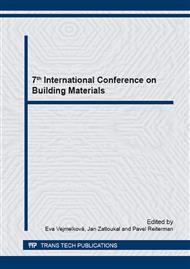[1]
B. Wolff, Hydrophobized Lime Plasters as Protective Surface in Wet Rooms in Monument Preservation, Adv. Mater. Res. 688 (2013) 60-69.
DOI: 10.4028/www.scientific.net/amr.688.60
Google Scholar
[2]
M. F. Rojas and J. Cabrera, The effect of temperature on the hydration rate and stability of the hydration phases of metakaolin-lime-water systems, Cem. Concr. Res. 32 (2002) 133 – 138.
DOI: 10.1016/s0008-8846(01)00642-1
Google Scholar
[3]
M. Pavlíková, Z. Pavlík, M. Keppert, R. Černý, Salt transport and storage parameters if renovation plasters and their possible effects on restored building's walls, Const. Build. Mater. 25 (2011) 1205-1212.
DOI: 10.1016/j.conbuildmat.2010.09.034
Google Scholar
[4]
Z. Pavlík, L. Fiala, J. Maděra, M. Pavlíková, R. Černý, Computational modelling of coupled water and salt transport in porous materials using diffusion advection model, J. Franklin I. 348 (2011) 1547-1587.
DOI: 10.1016/j.jfranklin.2010.06.014
Google Scholar
[5]
V. Kočí, J. Maděra, J. Fořt, J. Žumár, M. Pavlíková, Z. Pavlík, R. Černý, Service Life Assessment of Historical Building Envelopes Constructed Using Different Types of Sandstone: A Computational Analysis Based on Experimental Input Data, Sci. World J. Article ID 802509 (2014).
DOI: 10.1155/2014/802509
Google Scholar
[6]
ČSN EN 1015 – 11 Methods of test for mortar for masonry – Part 11: Determination of flexural and compressive strength of hardened mortar, Czech Standardization Institute, Prague, (2000).
DOI: 10.3403/01905442
Google Scholar
[7]
ČSN EN 1015 – 12 Methods of test for mortar for masonry – Part 12: Determination of adhesive strength of hardened rendering and plastering mortars on substrates, Czech Standardization Institute, Prague, (2000).
DOI: 10.3403/02027531u
Google Scholar
[8]
Z. Pavlík, L. Fiala, E. Vejmelková, R. Černý, Application of Effective Media Theory for Determination of Thermal Properties of Hollow Bricks as a Function of Moisture Content, Int. J. Thermophys. 34 (2013) 894-908.
DOI: 10.1007/s10765-012-1183-3
Google Scholar
[9]
ČSN 72 7031 Determination of water vapour diffusion coefficient of building materials by method without temperature gradient, Czech Standardization Institute, Prague, cancelled (2006).
Google Scholar
[10]
M. K. Kumaran, Moisture Diffusivity of Building Materials from Water Absorption Measurements. IEA Annex 24 Report T3-CA-94/01, Ottawa (1994).
Google Scholar
[11]
S. Bergheim, Hygroscopic material properties, Water vapour permeability and hygroscopic sorption curves for materials used in a test house. Project Report, Norwegian Building Research Institute, Trondheim, (1998).
Google Scholar
[12]
M. Záleská, M. Pavlíková, Z. Pavlík, R. Černý, Retention Curves of Different Types of Sandstone, Adv. Mater. Res. 982 (2014) 44-48.
DOI: 10.4028/www.scientific.net/amr.982.44
Google Scholar
[13]
ČSN 730540 – 3. Thermal protection of buildings - Part 3: Design value quantities, Czech Standardization Institute, Prague, (2000).
Google Scholar


